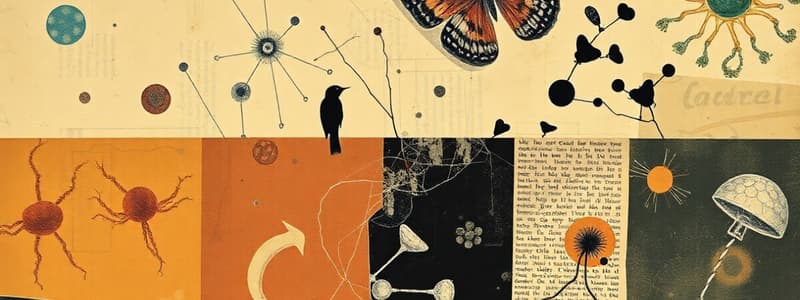Podcast
Questions and Answers
Which property of water allows it to stabilize temperature in living organisms?
Which property of water allows it to stabilize temperature in living organisms?
- Polarity
- Solvent capability
- High density
- High specific heat (correct)
What is the main result of dehydration synthesis between two amino acids?
What is the main result of dehydration synthesis between two amino acids?
- Production of water
- Formation of glucose
- Breaking down of proteins
- Formation of a peptide bond (correct)
In terms of enzyme function, what does the term 'induced fit' refer to?
In terms of enzyme function, what does the term 'induced fit' refer to?
- The substrate can fit into the enzyme without change
- Enzymes work best at any pH level
- The enzyme changes its shape to fit the substrate better (correct)
- Enzymes are not affected by temperature changes
In which part of the plant does the Calvin cycle take place?
In which part of the plant does the Calvin cycle take place?
Which term best describes the roles of producers and consumers in an ecosystem?
Which term best describes the roles of producers and consumers in an ecosystem?
What is the function of the mitotic spindle during mitosis?
What is the function of the mitotic spindle during mitosis?
Which statement correctly describes a distinguishing feature of prokaryotic cells?
Which statement correctly describes a distinguishing feature of prokaryotic cells?
What type of mutation results in a premature stop codon in protein synthesis?
What type of mutation results in a premature stop codon in protein synthesis?
Flashcards
Central Dogma of Biology
Central Dogma of Biology
The process of information flow in living organisms: DNA to RNA to protein.
Photosynthesis
Photosynthesis
The process by which plants use sunlight to convert carbon dioxide and water into glucose (sugar).
Enzyme
Enzyme
A biological catalyst that speeds up chemical reactions in the body.
DNA Replication
DNA Replication
Signup and view all the flashcards
Mitosis
Mitosis
Signup and view all the flashcards
Natural Selection
Natural Selection
Signup and view all the flashcards
Base Pairing Rules
Base Pairing Rules
Signup and view all the flashcards
Evolution
Evolution
Signup and view all the flashcards
Study Notes
Exam 1 (Ch. 1, 2)
- Effects of pH on proteins
- Characteristics of living things
- Central dogma
- Producers vs. consumers
- Water properties
- Organic compounds
- Isotopes
- Protein structure
- Acids vs. bases
- Hydrolysis vs. Dehydration synthesis
- Experimental design (independent vs. dependent variables)
- Adaptation
- Prokaryotes vs. eukaryotes
- Negative vs. positive control
Exam 2
- Ideal conditions for plant cell/animal cell (tonicity)
- Diffusion
- Factors that affect enzymes
- Enzyme structure and function (Induced fit, substrate, active site, activation energy)
- Animal cells vs. plant cells (structure)
- Endergonic vs. exergonic
- Structures found in all cells
- What happens to plant/animal cells in hypertonic, hypotonic, and isotonic conditions?
- Organelle functions
- Why are cells small?
- Membrane structure
- Domains of Life
Exam 3
- What is reduced vs. oxidized in cellular respiration & photosynthesis?
- Electron transport chain purpose
- Where do events of cellular respiration occur?
- Oxidation vs. reduction
- Autotrophic vs. heterotrophic
- Where do light reactions vs. Calvin cycle occur?
- Products of light reactions
- Wavelengths best for photosynthesis
- ATP
- How are cellular respiration and photosynthesis related?
- Cristae
Exam 4
- Double helix
- Number of chromosomes in normal human diploid/haploid cells
- Percentages of each nucleotide when one is known
- Purpose of mitosis
- Base pairing rules
- Transcription & translation
- Point mutation - base substitution
- Nonsense mutation
- Mitotic spindle
- Cancer
- Leading vs lagging strand
- Interphase
- Gene
- DNA vs. RNA
- Binary fission
- DNA replication purpose
- Mutation
- Codon chart
Last Unit
- Purpose of meiosis
- Natural selection
- Why gametes must be haploid
- Homozygous vs. heterozygous
- Phenotype vs. genotype
- Sex-linked traits
- Simple dominant vs. recessive (monohybrid crosses)
- Alleles
- Determining gamete combinations from parental genotypes
- Blood type crosses (multiple alleles)
- Predicting probability of offspring outcomes
- Evolution
- Natural selection acts on individuals, but evolution occurs in populations
- Absorption spectrum for chlorophyll
- Conditions for stomatal closing/opening
- Color absorbed/reflected
- Location of O2 release by plants
- Terminal electron acceptor in cellular respiration
Studying That Suits You
Use AI to generate personalized quizzes and flashcards to suit your learning preferences.
Related Documents
Description
This quiz covers key concepts from the first three chapters of a biology course, including the effects of pH on proteins, cell structure comparison, and the processes of cellular respiration and photosynthesis. Study topics like enzyme function, cell tonicity, and the central dogma of molecular biology to prepare effectively for your exams.



